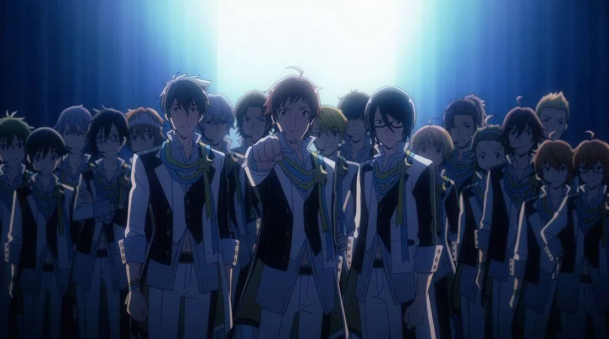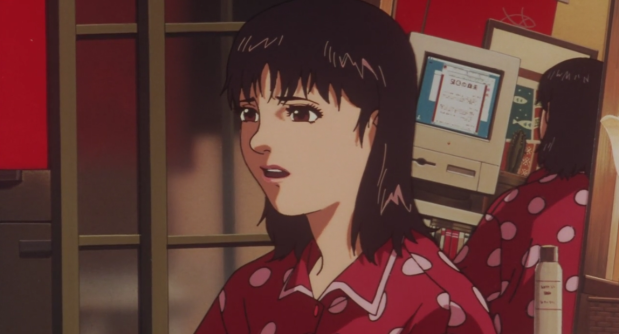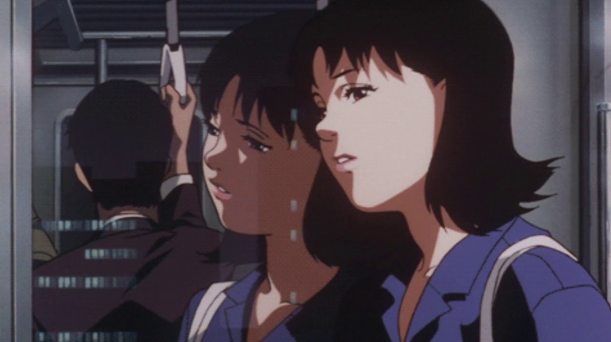Chances are that if you were linked here from another blogger pal, then you might be new. To those first-timers, “Hi, I’m Takuto, welcome to my anime cafe!” For the OWLS blog tour’s first monthly topic of 2020, “Visions,” I wanted to engage in a side of me that I’ve been neglecting for some time: My interest in idol culture, and how idols can actually inspire their fans to strive to become their best selves.
Happy New Year! Since it is a new year, it’s a new you! This month we will be talking about various pop culture mediums that focus on envisioning “the future.” What type of future do we want for ourselves, our communities, and the world? Also, we will be sharing our goals and plans for the new year.
The New Year’s celebration is my favorite time of the year. I buy hard into that whole “New Year, New Me” business, so really, it’s all one big self-care holiday for me. Thanks Lyn for the prompt!

A brief discussion of the 13-episode fall 2017 anime “Idolmaster SideM,” stylized as “The iDOLM@STER: SideM,” animated by A-1 Pictures, directed by Miyuki Kuroki, and based on the franchise rhythm game of the same name.
A Fresh Change of Pace
Talent recruitment and entertainment agency 315 Productions may be in its infant stage, but the calm and caring producer of 315 promises his idols a place on the world stage so long as they work hard toward their dreams. Specializing in scouting prospective idols who previously held other jobs, all have a place at the agency, whether a former lawyer, pilot, or even a surgeon. As these men—some in their mid thirties, others still living their high school days—grow to understand their new positions, they’ll have to make sacrifices and trust in each other if they are to achieve their dream of becoming top idols!
Is this really a story about grown men who are sick of their lives and willing to gamble away their careers to sing and dance on a stage? Wow, it’s no wonder I liked this anime so much. Idolmaster SideM is a tale of reinvention for its stunning ensemble of idols, each with an origin story more different from the last. In just 13 episodes, we hear from a whopping 19 different men and how their individual lives have aligned at the crossroads of music and fame.
Some accounts are far more detrimental than others, say, the pilot who left his job because his anxiety overcame him in a near-fatal crash vs. the quiet boy who just wanted to come out of his shell. Or the twins who abandoned their professional athletic career due to one being burdened by a substantial injury compared to the guy who went along with it cause his buddy did. Again, each story is different, but not one of their ambitions are to be deemed “lesser” than the other’s. In fact, it’s thanks to this variety of perspectives on seeking change and self-improvement that Idolmaster SideM allows itself to be light-hearted yet feel grounded and real—inspirational, yet with one foot in reality’s door.

Creating the Idol “Brand”
What does it take to be an idol? Geez, one could go down all different routes to answer that one. To keep things relevant to this post, I want to focus on the concept of brands, AKA one’s identification or signature style. For example, my blogging brand (or so I hope) is marked by its connections to good vibes and clean aesthetic under the theme of an urban city cafe. How does an idol group go about designing their brand? The six young idol units of SideM quickly discover that there’s a lot more to it than color-coordinated costumes and snazzy photography.
For idols, especially the bigger name groups like 315’s Jupiter, everything down to the very way you live your own life determines how the group is perceived. If a famous idol were to be seen drinking a specific soda type or repping a certain fashion brand on a given day, their fans might perceive this beverage and that jacket as elements common to the idol’s life (even if purely coincidental), thus branding the idol’s group with these particular companies. Fans may eventually try to match their favorite groups by supporting these companies and buying their products, which feeds back into the industry itself. So yeah, brands matter.

When it comes to envisioning their own brand, the ex-lawyer, pilot, and surgeon of DRAMATIC STARS struggle with what to wear during their first photo shoot. Jupiter’s black leather is too cool for them; High×Joker and Beit’s wild colors and textures seem too childish. So, they settle on wearing the uniforms of their respective careers in hopes of representing the most true versions of themselves. While it’s not the most pleasing collection of outfits, it’s certainly an original look that they feel most comfortable with being known for.
Tsubasa and I, and everyone from 315 Productions, have led different lives, and different circumstances brought us all here together. We all have our reasons, but the goal has always been the same. We’re chasing the same dream together! — Teru Tendo
Connecting Brands to Reality
All this talk about idols and branding and representation got me to thinking about how I want to market my own personal brand. Between falling back into K-pop hell and observing how real idols create the personas they desire, to expanding my own platform with an Instagram, it’s definitely been on my mind.
What do we, as bloggers, want our personal brands to look like? How can we achieve this vision of ours? Takuto is obviously not my real name, and unfortunately, I do not own my own cafe, let alone work at one. These were decisions I made to “create” the Takuto you know today. Everything from my blog’s theme colors to the way I interact in the comments (like how I use the ~ all the time) were choices.
So, how do we do it, creating our “online selves”? Just like with the DRAMATIC STARS trio, it’s a tricky balance of being true to yourself while also pursuing the change you desire in life. The anime and manga I review inform you about my tastes in entertainment. Thus, it should be my goal to highlight the types of shows and series I personally love and collect through my posts (with exceptions to sharing an honest opinion), be it with words or pictures. And if I find my tastes changing, perhaps it wouldn’t be such a bad idea to address any waning interests, or invite you to witness any exciting new finds either in my watch list, on my shelves, or even in my personal life.

As bloggers, as writers, we have one goal: to connect with our readers. In that way, we aren’t that different from pop idols that strive to connect with their fans. If we hide behind fake interests or write a lackluster review over a series, they will be able to tell. They always do. If you don’t have anything to say about a given series (yet feel “forced” to review it anyway), perhaps you should dedicate that time and energy into a post you could absolutely gush over, be it for something you intensely love or extremely dislike.
However, we should also acknowledge that interests can also change—if a blogger wants to add a new segment to their site, try out a new platform outlet, or simply take a break from their normal content to just write about themselves, we should embrace their efforts and support them in all their new endeavors. I mean, unlike idols, you can become truly close friends with an internet content creator. Why would you not pay it forward while you can? In all that you do, be cautious, but be yourself—the best things will come from doing just that.

We’re All Just Trying to Create
As creators of some kind of content, it can be easy to let the issue of personal branding slide under the rug. Little do we or they (the ones that get paid millions to stand on the world stage) realize the impact that even the most seemingly insignificant aspects of our lives have on the perceptions of others. Especially as bloggers, these are points that we don’t really ever lend coverage to, and I think that’s part of the reason why it might seem difficult to become a socially “successful” internet blogger. We’re a quiet people often hidden behind walls of text. But, that doesn’t necessarily mean we are impersonal people—in fact, I find writers to be some of the most relatable humans out there, but that’s a post for another day.
In a roundabout way, Idolmaster SideM tackles very similar issues about perception and personal branding that internet content creators must deal with. Additionally, the series confronts the realities of what it means to be “associated” with a particular vibe or energy, as well as the physical and mental training idols must undergo to achieve that vision. It’s an awful lot, and at the end of the day, we’re all just trying to create something people can love. So, whether a complete novice or one of the billboard’s top hits, one thing’s for sure: There’s no such thing as a lazy idol.

They are the ones that worked hard. All I did was talk to those brilliant people. — Producer
Afterword
Frankly speaking, there’s a lot of “good” going on in Idolmaster SideM. Watching each of 315 Productions’ idol groups grow is a daunting task thanks to the short series run, but an incredibly fulfilling one despite the odds. Following these guys side-by-side as they stumble in practice and struggle with clashing personality differences is an endearing process. I can walk away from this anime saying, “YES, they’re all good boys!!” as I finally grasp the appeal behind male idol anime. Simply for its inspirational premise of throwing caution to the wind and saying “Screw it, I wanna be famous,” Idolmaster SideM is a certified “Cake” here at the cafe! Got any thoughts on the series or idol culture in general? I’d love to hear them down in the comments.
This concludes my January 14th entry in the OWLS “Visions” blog tour. My good buddy Matt (Matt-in-the-Hat) went right before me with a personal post over the hit film Spider-Man: Into the Spider-Verse that you can read right here! Now, look out for Aria (The AniManga Spellbook) as she walks us through antiquity and the future in Dr. Stone this Thursday, January 16th! Thank you so much for reading, and until next time, this has been
– Takuto, your host











